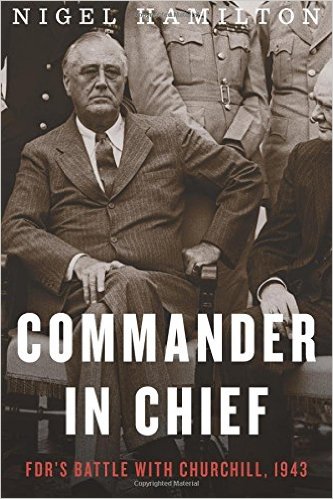
Finest Hour 176
Books, Arts, & Curiosities – Clash of the Titans

July 25, 2017
Finest Hour 176, Spring 2017
Page 45
Review by Richard A. McConnell
Nigel Hamilton, Commander in Chief: FDR’s Battle with Churchill , 1943, Houghton Mifflin Harcourt, 2016, 480 pages, $30.00. ISBN 978-0544279117
“I am everlastingly angry only at those who assert vociferously that the four freedoms and the Atlantic Charter are nonsense because they are unattainable. If these people had lived a century and a half ago they would have sneered and said that the Declaration of Independence was utter piffle.”
This 1943 statement by President Franklin Roosevelt is a stellar example of visionary rhetoric and is one of many examples of FDR’s drive to use the Four Freedoms (Freedom of Speech and Worship; Freedom from Want and Fear) as his compass to lead the war effort. In his latest book on Roosevelt during the Second World War, Nigel Hamilton continues his quest to give FDR his “day in literary court.”
This engaging read is Hamilton’s second volume (Mantle of Command being the first and reviewed in FH 168) investigating Roosevelt’s continued maturation into the role of commander in chief. Hamilton’s narrative goes beyond Roosevelt’s challenges commanding the US war effort. This account captures the myriad trials associated with galvanizing world leaders toward a vision of the post-war world. FDR used notions that, although they may have been novel at the time, have now been accepted as foundational for organizations such as the United Nations and NATO. Thus, this latest account engagingly describes a seminal moment in world history created by a dynamic leader, which changed the world permanently.

2024 International Churchill Conference
The book’s subtitle, FDR’s Battle with Churchill, might imply open hostility between the warlords, which would be incorrect. This is not an anti-Churchill book. Hamilton depicts a complex picture of this historic alliance, which really was a close friendship that included intense competition. Both men were strong leaders, but each had distinctly different strengths and challenges. Without this collaboration, our present world would be very different.
Hamilton provides a remarkable description of FDR as both uncompromising and diplomatic. In 1943, the president was growing into the role of commander-in-chief of an allied effort that was far from unified. This book contains riveting descriptions of how decisions that might be taken for granted today almost did not happen, potentially changing the outcome of the war.
Commander in Chief is a study in how a national leader established a vision and used it to guide world leaders through the cauldron of conflict to a brighter future. To do this, Hamilton continues to draw from speeches, official documents, and personal journals, providing the reader with more than what was publicly released at the time. This account includes what military leaders, politicians, and private citizens captured in their journals regarding what they saw. This combination of sources helps provide the reader with rich descriptions resembling a literary time capsule, which is especially effective.
One of Hamilton’s most engaging techniques is to compare and contrast journal entries of perceptions of events as they occurred with what was considered official policy. For example, he describes differences between the agreements at the Casablanca conference in early 1943 and subsequent British and American war plans. In Casablanca, Churchill agreed to a cross-channel invasion of the continent of Europe in 1944 and set the planning in motion for such an endeavor. Numerous journal entries, however, chronicled British reluctance to pursue such an invasion plan, resulting in incessant conflict between allied planners. Roosevelt was finally able to force Churchill’s support of the Casablanca agreements by using the sharing of Manhattan Project nuclear research as a bargaining chip. These back-and-forth negotiations caused great friction between the allies and very nearly caused the cancelation of the invasion that brought the war to an end.
Hamilton crafts a captivating read, recounting a foundational moment in world history and how FDR helped create the world order under which we live today. The president understood that war is terrible but, if it is to be pursued at all, the results must justify its dreadful cost. The title Commander in Chief might imply to some a leadership style emphasizing a dictatorial approach—not so with Roosevelt. In 1943, FDR continued to develop the unique leadership quality known as command while guided by what became his creed: the Four Freedoms. This book is an appealing example of how leaders can develop a vision based on the fundamental values of their institutions and apply that vision to making the world better.
Richard A. McConnell is an Assistant Professor in the Department of Army Tactics at the US Army Command and General Staff College.
Subscribe
WANT MORE?
Get the Churchill Bulletin delivered to your inbox once a month.


